Serving 579 students in grades 6-8, John P. Fishwick Middle School ranks in the bottom 50% of all schools in Virginia for overall test scores (math proficiency is bottom 50%, and reading proficiency is bottom 50%).
The percentage of students achieving proficiency in math is 33% (which is lower than the Virginia state average of 54%). The percentage of students achieving proficiency in reading/language arts is 60% (which is lower than the Virginia state average of 69%).
The student:teacher ratio of 15:1 is higher than the Virginia state level of 14:1.
Minority enrollment is 70% of the student body (majority Black and Hispanic), which is higher than the Virginia state average of 56% (majority Black and Hispanic).
Quick Stats (2025)
- Grades: 6-8
- Enrollment: 579 students
- Student:Teacher Ratio: 15:1
- Minority Enrollment: 70%
- Overall Testing Rank: Bottom 50% in VA
- Math Proficiency: 33% (Btm 50%)
- Reading Proficiency: 60% (Btm 50%)
- Science Proficiency: 40-44% (Btm 50%)
- Source: National Center for Education Statistics (NCES), VA Dept. of Education
Top Rankings
John P. Fishwick Middle School ranks among the top 20% of public schools in Virginia for:
Category
Attribute
Diversity
Percent Eligible For Free Lunch
School Overview
John P. Fishwick Middle School's student population of 579 students has grown by 9% over five school years.
The teacher population of 38 teachers has stayed relatively flat over five school years.
Grades Offered
Grades 6-8
(offers virtual instruction)
(offers virtual instruction)
Total Students
579 students
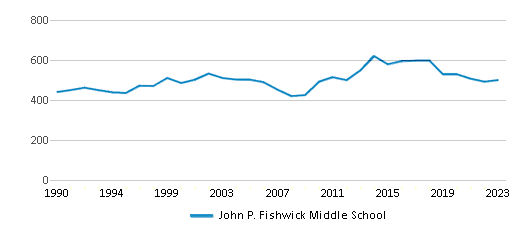
Gender %
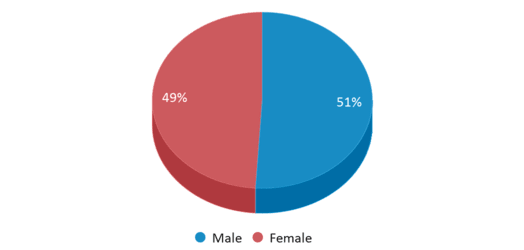
Total Classroom Teachers
38 teachers
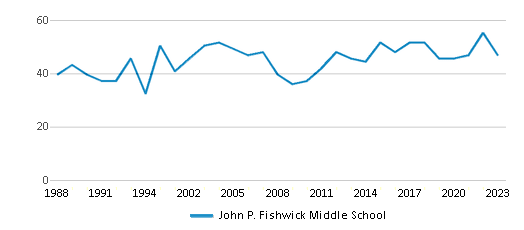
Students by Grade
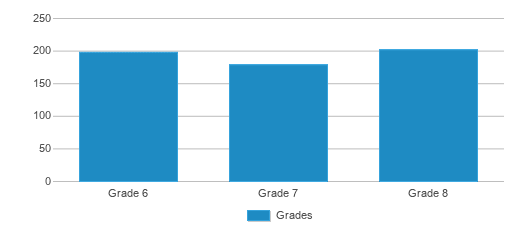
School Rankings
John P. Fishwick Middle School ranks within the bottom 50% of all 1,792 schools in Virginia (based off of combined math and reading proficiency testing data).
The diversity score of John P. Fishwick Middle School is 0.75, which is more than the diversity score at state average of 0.72. The school's diversity has stayed relatively flat over five school years.
Overall Testing Rank
#1416 out of 1792 schools
(Bottom 50%)
(Bottom 50%)
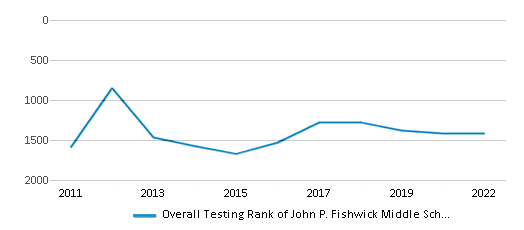
Math Test Scores (% Proficient)
(20-21)33%
54%
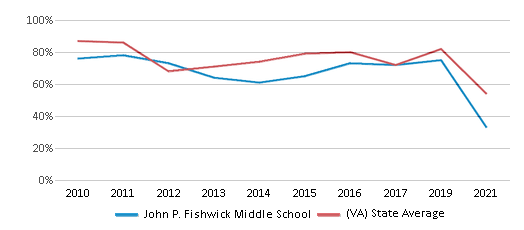
Reading/Language Arts Test Scores (% Proficient)
(20-21)60%
69%
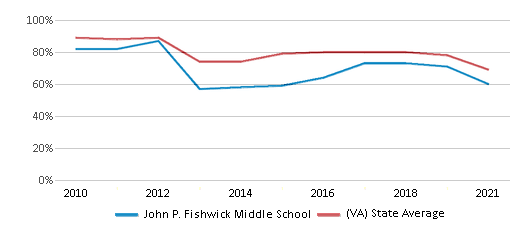
Science Test Scores (% Proficient)
(20-21)40-44%
59%
Student : Teacher Ratio
15:1
14:1
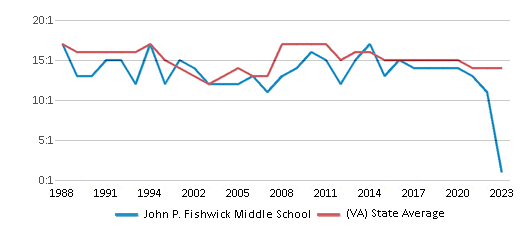
American Indian
n/a
n/a
Asian
6%
8%
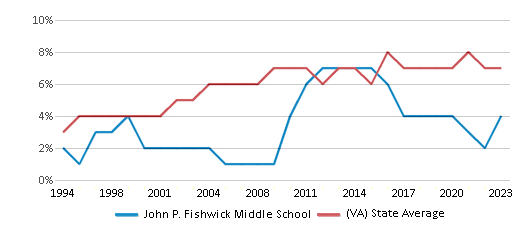
Hispanic
28%
19%
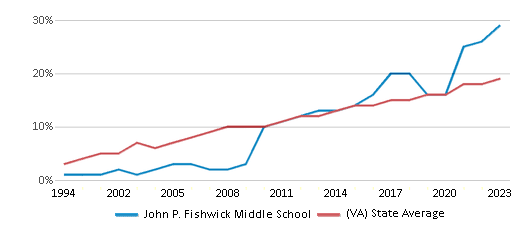
Black
28%
22%
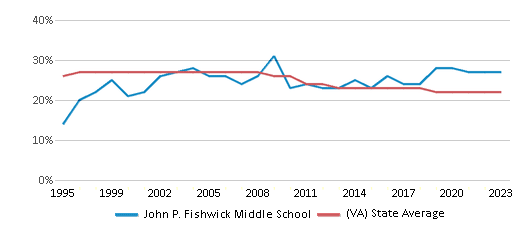
White
30%
44%

Hawaiian
n/a
n/a
Two or more races
8%
7%
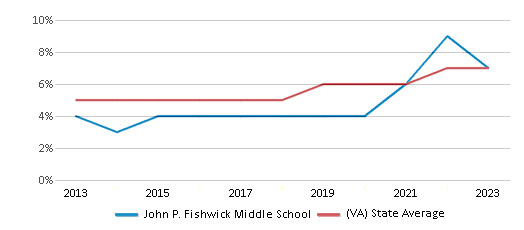
All Ethnic Groups
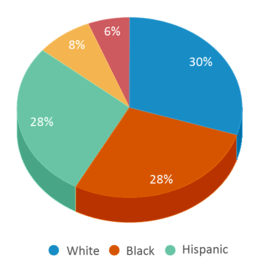
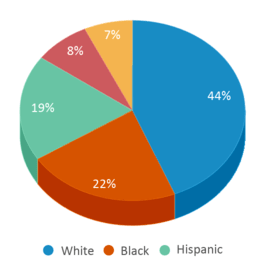
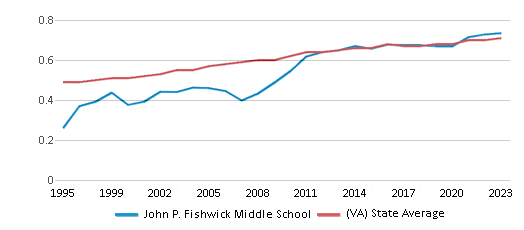
Eligible for Free Lunch
99%
55%
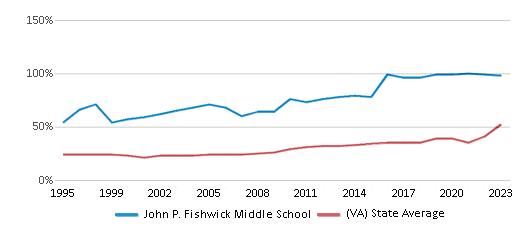
Eligible for Reduced Lunch (14-15)
7%
6%
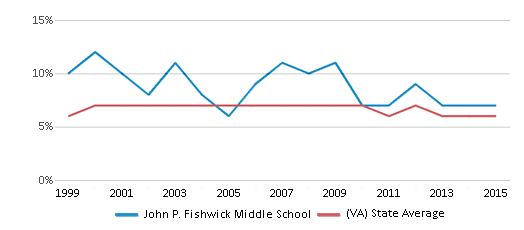
School Statewide Testing
School District Name
Source: National Center for Education Statistics (NCES), VA Dept. of Education
Profile last updated: 02/09/2025
Frequently Asked Questions
What is John P. Fishwick Middle School's ranking?
John P. Fishwick Middle School is ranked #1416 out of 1,792 schools, which ranks it among the bottom 50% of public schools in Virginia.
What schools are John P. Fishwick Middle School often compared to?
John P. Fishwick Middle Schoolis often viewed alongside schools like Breckinridge Middle School, Addison Aerospace Magnet Middle School by visitors of our site.
What percent of students have achieved state testing proficiency in math and reading?
33% of students have achieved math proficiency (compared to the 54% VA state average), while 60% of students have achieved reading proficiency (compared to the 69% VA state average).
How many students attend John P. Fishwick Middle School?
579 students attend John P. Fishwick Middle School.
What is the racial composition of the student body?
30% of John P. Fishwick Middle School students are White, 28% of students are Black, 28% of students are Hispanic, 8% of students are Two or more races, and 6% of students are Asian.
What is the student:teacher ratio of John P. Fishwick Middle School?
John P. Fishwick Middle School has a student ration of 15:1, which is higher than the Virginia state average of 14:1.
What grades does John P. Fishwick Middle School offer ?
John P. Fishwick Middle School offers enrollment in grades 6-8 (offers virtual instruction).
What school district is John P. Fishwick Middle School part of?
John P. Fishwick Middle School is part of Roanoke City School District.
School Reviews
2 11/7/2013
I feel the teachers are perfectly fine especially in the conditions in which they work. They do their job the best they can with what they are supplied with. They may be a little harsh but with kids fighting everyday and constant outbursts they have to be strict and punctilious in order for there to be any foundation. The ethnicity at Stonewall is dangerous especially in a hood rat neighborhood where the boys are being born into a life of crime and drugs where as the girls are being born into a life of dealing with deadbeat spouses. So no the teachers are fine its the parents who refuse to set boundaries for their children and the children who create such a violent atmosphere that makes Stonewall Jackson another dead end for potential
5 4/18/2011
I like Stonewall Jackson Middle School alot, except some teachers really shouldn't have a job here, much less a license. There are good kids, and a good school altogether, but they should really reconsider certain teachers.
Review John P. Fishwick Middle School. Reviews should be a few sentences in length. Please include any comments on:
- Quality of academic programs, teachers, and facilities
- Availability of music, art, sports and other extracurricular activities
Recent Articles

What Is A Charter School?
Explore the world of charter schools in this comprehensive guide. Learn about their history, how they operate, and the pros and cons of this educational innovation. Discover key facts about charter schools, including admission policies, demographics, and funding, as well as what to look for when considering a charter school for your child.

10 Reasons Why High School Sports Benefit Students
Discover the 10 compelling reasons why high school sports are beneficial for students. This comprehensive article explores how athletics enhance academic performance, foster personal growth, and develop crucial life skills. From improved fitness and time management to leadership development and community representation, learn why participating in high school sports can be a game-changer for students' overall success and well-being.

February 05, 2025
Understanding the U.S. Department of Education: Structure, Impact, and EvolutionWe explore how the Department of Education shapes American education, from its cabinet-level leadership to its impact on millions of students, written for general audiences seeking clarity on this vital institution.





